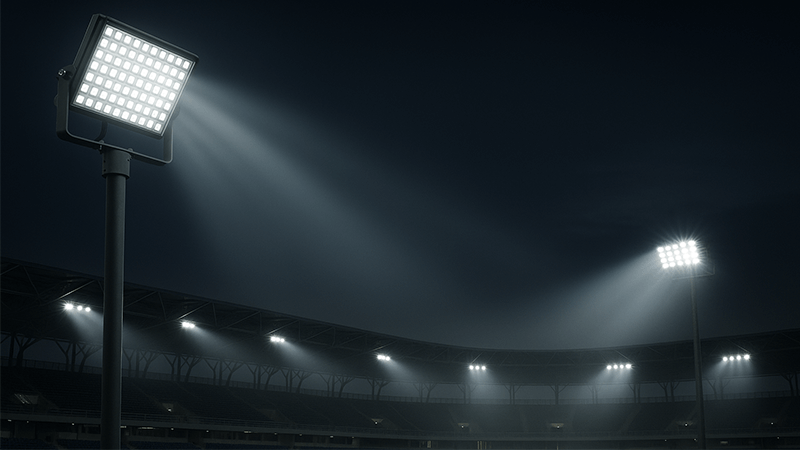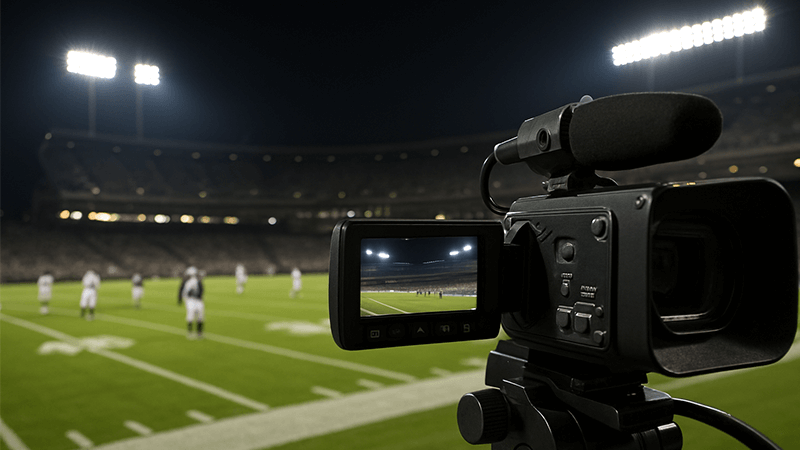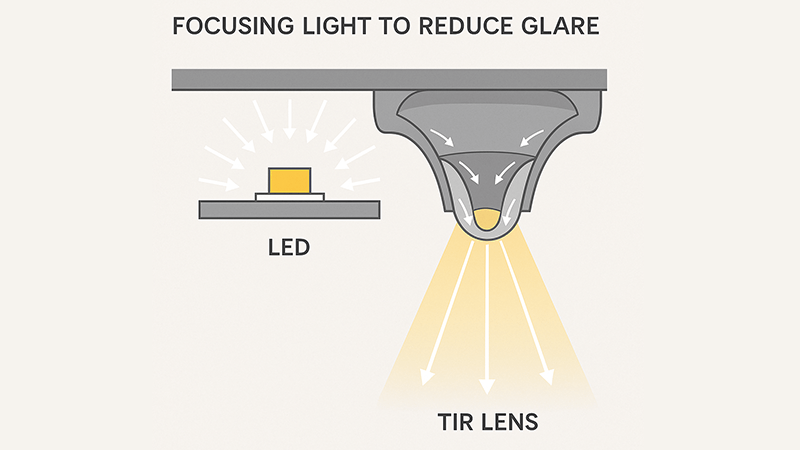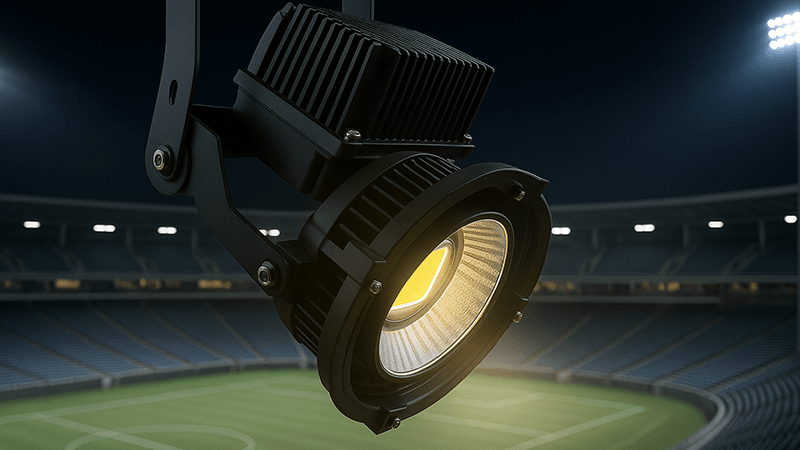Last Updated on: September 1, 2025Choosing the wrong stadium lights can be a costly mistake. But understanding the core technology means you can select the right product with confidence, ensuring perfect illumination every time.
The best LED floodlights for stadiums offer superior optical control to minimize glare, excellent thermal management for longevity, and a high Television Lighting Consistency Index (TLCI) for flawless broadcasting. It’s about a complete system of quality components, not just one headline feature like brightness.

When I first started in this industry, everyone was obsessed with watts and lumens. It was a race to see who could claim the biggest number on their spec sheet. But after years of manufacturing and seeing what actually works on the field, I’ve learned that the true markers of quality are much deeper than that. Focusing on the wrong things leads to expensive problems. Let’s look at what really matters when you need to light a professional sports venue.
What is the best brand of LED floodlight?
You’re searching for the "best brand," thinking it’s a simple answer. But top brands can be expensive, and lesser-known ones feel risky. The solution is to evaluate the components inside.
There is no single "best" brand. A superior floodlight is built with top-tier components from trusted sources like Lumileds for LEDs and Mean Well for drivers. The brand on the housing is less important than the quality of the parts making it work.
[^2] of an LED floodlight, showing the chip and driver.](https://upwardlighting.com/wp-content/uploads/2025/08/SST2.png)
Why the Sum of the Parts Matters More
Over the years, I have seen many purchasing managers, like my friend Shaz in the UAE, focus too much on the fixture’s brand name. This is a common mistake. The reality is that the final assembler is only one part of the equation. The performance and reliability of a stadium floodlight depend almost entirely on the quality of its internal "component ecosystem." A great LED chip will fail quickly if it’s powered by a cheap driver or attached to a poorly designed heat sink. It’s a system where the weakest link determines its lifespan. When we build our lights at Upward Lighting, we think about this system first.
For example, a client once proudly showed me a set of new lights from a very famous brand. They looked great. But within 18 months, over 30% of them had failed. When we opened one up, we found they had used no-name, uncertified internal parts to cut costs. The brand name was just a shell. This is why you must ask your potential supplier for a complete bill of materials. You need to know exactly what you are buying. True quality isn’t about the logo on the outside; it’s about the engineering on the inside.
| Component |
Top-Tier Brands |
Why it Matters |
| LED Chips |
Lumileds, Cree, Nichia |
Determines efficiency (lumens per watt), color quality, and how long the light output lasts. |
| LED Driver |
Mean Well, Inventronics |
Provides stable, clean power. Protects against power surges and allows for dimming and control. |
| Optics/Lenses |
LEDiL, Internal Design |
Precisely directs the light onto the field, preventing glare for players and spill for neighbors. |
| Thermal System |
Proprietary Designs |
Manages heat, which is the number one killer of LEDs. Good design ensures longevity and performance. |
How many lumens are stadium lights?
You need to know the lumen count for your project specifications. But quoting only lumens can lead to poor lighting quality, especially for TV broadcasts. Let’s look beyond raw brightness.
Stadium floodlights typically range from 60,000 to over 200,000 lumens per fixture. However, for professional venues, the Television Lighting Consistency Index (TLCI) is a more critical metric than lumens alone. It ensures colors look true and vibrant on camera.

Moving Beyond Lumens to TLCI
The number of lumens you need depends completely on the venue and level of competition. A local community field might only need 50,000-lumen fixtures to achieve 200-300 lux on the ground. A professional stadium hosting international broadcasts, however, needs fixtures producing 150,000 lumens or more to reach 1,500-2,500 lux. But even that is not the full story. Brightness is useless if the light quality is poor.
This is where the Television Lighting Consistency Index (TLCI) comes in. Think of it like the Color Rendering Index (CRI), but made specifically for the sensors in modern broadcast cameras. A light with a low TLCI might look fine to the human eye, but on camera, it can make the green grass look yellowish and cause players’ skin tones to appear unnatural. For any event that will be filmed, a TLCI score of 90 or higher is non-negotiable. I remember a project where a competitor won the bid based on a very high lumen count for a low price. The lights were indeed bright. But the first time a local news station came to film a game, the broadcast was a disaster. The video was flickering and the colors were completely wrong. The stadium had to pay a fortune to replace the new lights with broadcast-ready fixtures that had a high TLCI. They learned a hard lesson: for modern stadiums, lumens get you in the game, but TLCI lets you win.
| Metric |
What it Measures |
Good Score (Broadcast) |
Impact of a Low Score |
| Lumens |
Total light output (brightness) |
Varies by project |
Insufficient light on the field |
| Lux |
Light intensity on a surface |
~1500-2500 lux |
Dark spots, uneven playing surface |
| TLCI |
Color accuracy for cameras |
>90 |
Unnatural skin tones, flicker on screen |
Which bright, low-glare lights are often used to light outdoor sports stadiums?
You need bright lights, but they often create blinding glare. This glare can ruin the game for players and annoy nearby residents. True quality lies in controlling the light, not just producing it.
The best stadium lights use advanced individual TIR (Total Internal Reflection) lenses for each LED. These shape the light with precision, directing it onto the field while minimizing glare for players and spill light for neighbors. It is about control, not raw power.

Mastering Light with Advanced Optics
There is a paradox in lighting: the more powerful a light source is, the harder it is to control. This is the core challenge with stadium lighting. Creating a lot of lumens is the easy part. The hard part is putting that light exactly where you want it—on the field—and keeping it from going where you don’t want it—into the eyes of players, spectators, and nearby homes. This is where the science of optics becomes the most critical feature.
In the early days of LED, most fixtures used simple, large polished metal reflectors. These were inefficient and created a huge amount of glare. The next step was a single, large polycarbonate lens over the whole fixture. This was better, but still not precise. Today, the gold standard is using an individual, small TIR (Total Internal Reflection) lens for every single LED chip. This approach allows us to control the light with unmatched precision. We can create very narrow beams to throw light hundreds of meters, or wide, uniform beams for areas close to the poles. This is what separates a professional fixture from a simple floodlight. Before any major project, we run a complete DIALux simulation. This software uses IES files—a digital map of how a light fixture distributes light—to build a 3D model of the stadium. We can test everything digitally before a single light is installed, guaranteeing perfect uniformity and eliminating glare.
| Optic Type |
Light Control |
Glare Level |
Efficiency |
Best For |
| Polished Metal Reflector |
Poor |
Very High |
Low |
Old, non-professional fields |
| Single PC Cover Lens |
Moderate |
High |
Moderate |
Parking lots, general area lighting |
| Individual TIR Lenses |
Excellent |
Very Low |
High |
Professional stadiums, airports, ports |
You need to know what lights top football stadiums use. But simply copying their choice might not work for your budget or your local climate. You must understand the core technology that keeps them running.
Modern football stadiums use high-power LED floodlights, from 500W to 1500W. The most critical feature is superior thermal management. Systems with separated drivers and advanced heat sinks ensure performance and longevity under intense, continuous use.

The Unseen Battle: Winning with Thermal Management
For the high-wattage fixtures used in football stadiums, heat is the number one enemy. Excessive heat dramatically shortens an LED’s lifespan, causes its light output to fade over time (a process called lumen depreciation), and can even make the color of the light change. A common misconception is that a bigger, heavier heat sink is always better. This is not true. It is not about mass; it is about smart design. The best thermal management is a complete system. I like to call it “system-level thermal sovereignty.” Every part is designed to work together to get heat away from the sensitive LED chips as quickly as possible.
Imagine a high-performance race car. Its power is useless without an equally high-performance cooling system for the engine. A stadium light is the same. First is the heat sink itself. We use designs with cold-forged aluminum fins that create maximum surface area and promote natural airflow to carry heat away. Second, we separate the power supply (the driver) from the LED module. The driver is the hottest component and moving it away from the LEDs keeps both parts cooler and makes maintenance much easier. For clients in very hot climates like the UAE, this single design choice can add years to the life of the fixture. Finally, even the tiny layer of thermal paste between the LED board and the heat sink is critical. Using a high-quality material ensures a perfect transfer of heat. When you choose a light, you are not just choosing a bright chip; you are investing in the cooling system that will protect it for the next decade.
Conclusion
The best stadium light is a system of quality components, superior optics, smart thermal management, and a focus on broadcast-ready TLCI—not just a contest for the most lumens.